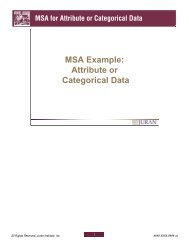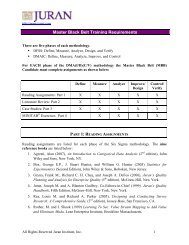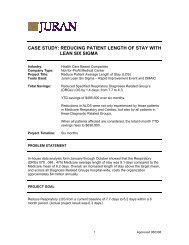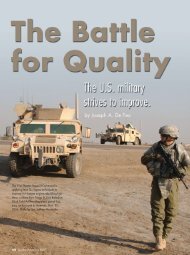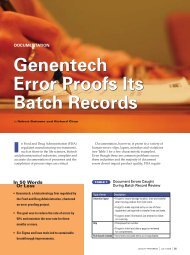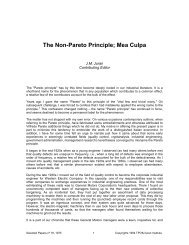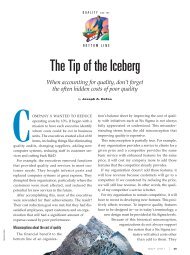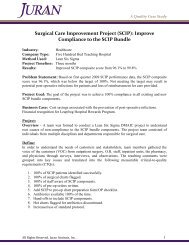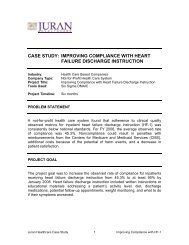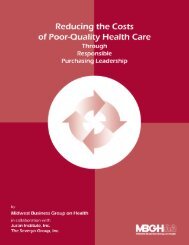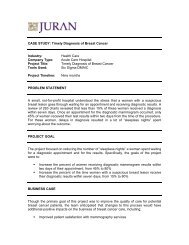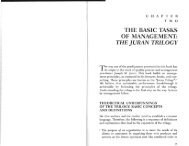Pressure Ulcer Prevention Improvement - Juran Institute
Pressure Ulcer Prevention Improvement - Juran Institute
Pressure Ulcer Prevention Improvement - Juran Institute
Create successful ePaper yourself
Turn your PDF publications into a flip-book with our unique Google optimized e-Paper software.
A Quality Case Study<strong>Pressure</strong> <strong>Ulcer</strong> <strong>Prevention</strong> <strong>Improvement</strong>Industry: HealthcareCompany Type: Not-for-Profit HospitalProject Title: <strong>Pressure</strong> <strong>Ulcer</strong> <strong>Prevention</strong> <strong>Improvement</strong>Tools Used: Six Sigma DMAICProject Timeline: Sixteen monthsTotal Savings: $1,852,000 annuallyProblem Statement: In July 2007, a medium-sized hospital conducted a prevalence andincidence study that identified an 18% incidence rate of hospital-acquired pressure ulcers, basedon quarterly prevalence and incidence data. This 18% was unacceptably high compared to a 7%national benchmark incidence rate. Incidence rates include all pressure ulcers including stages Ithrough IV, unstageable, and suspected deep tissue injury (DTI). The hospital identified 538hospital-associated pressure ulcers in 2007.Project Goal: The project goal was to reduce the incident rate of hospital-acquired pressureulcers from 18% to 5% by October 15, 2008 (a 72% reduction).Business Case: The Centers for Medicaid and Medicare Services (CMS) implementedguideline changes such that as of October 2008, they would no longer reimburse for hospitalacquiredpressure ulcers, leaving responsibility for all related expenses to the hospital. Currentcosts amount to $2,537,208 annually. A 72% reduction in incidence will result in an annual costsavings of $1,852,232. Additional benefits also may be realized, including increased patientsatisfaction and cost savings associated with material usage and time spent for treatment.Project:Overview - Plagued with increasing costs and decreasing insurance reimbursement, preventionof pressure ulcers provided an area of great cost savings opportunity for the hospital. A team wasformed to conduct a Six Sigma DMAIC (Define, Measure, Analyze, Improve, and Control)project to address potential root causes of the high incident rates and develop creative methods tobring the rates down to the target. Within the scope of inpatient admission through discharge, theteam focused on preventing hospital-acquired pressure ulcers and exacerbation of pressure ulcerspresent on admission. Left out of scope were non-hospital acquired pressure ulcers, pediatrics,mother/baby, NICU, PICU, SNF, Outpatient services, and RNM facilities other than DCT.Define:To better define and understand the process and ultimately determine what critical elementsneeded to be addressed to attain a high level of quality, the team developed a SIPOC (Supplier,Input, Process, Output, and Customer) high level process map. In addition to the major processsteps, this map clarifies the suppliers at the front end affecting the process, the materials andother inputs entering the process, what materials and outputs exit the process, and ultimately thecustomers impacted by the process. After condensing the customer list to the “vital few”—patients, families, nurses, physicians, and ancillary services—the following question was askedof these customers in interviews:All Rights Reserved, <strong>Juran</strong> <strong>Institute</strong>, Inc. 1
A Quality Case Study“What is important to you regarding skin care when in the hospital, especially woundscaused by pressure, commonly called bed sores?"Analysis of the answers, or Voice of the Customer, helped determine the elements critical toquality in the process. If the process can address the needs seen as critical by its customers, thenit is seen as a highly effective process. The three key issues discovered were:• Maintain skin integrity• Education and standardized integrated process• Communication and collaborationMeasure:With the key issues in mind, the team set out to measure the current state of the process anddetermine the baseline status against which any future changes could be compared. From aquantitative approach, after validation of the measurement system and collection of data, theteam determined that the current process operated at a sigma level of 2.4, reflecting the 18%incident rate. Aiming to achieve a maximum target incident rate of 5%, the process wouldimprove to a capability of 3.2 sigma. Because there was a lack of good data for process metricsat the beginning of the project, the team developed plans for acquiring these data during thecourse of the project.From a qualitative approach, a more detailed map was created identifying the process flow forpressure ulcer prevention and in caring for a pressure ulcer patient. Brainstorming and discussionof the map provided possible theories (potential root causes) as to why, how, and where pressureulcers occurred. The team constructed a cause and effect diagram to identify the potential factors(Xs) that contribute to Hospital Acquired <strong>Pressure</strong> <strong>Ulcer</strong>s (Y).Analyze:Analysis of the cause and effect diagrams consolidated the overwhelming number of possibleroot causes to a list of 11. These were:• X1: The development of a hospital-acquired pressure ulcer in a patient is dependent onthe Braden score being done on admission (within eight hours).• X2: The development of a hospital-acquired pressure ulcer in a patient is dependent onpatient turnover.• X3: Nurses do not have easy access to appropriate knowledge and interventioninformation regarding pressure ulcers.• X4: The development of a hospital-acquired pressure ulcer in a patient is dependent onbeing admitted through the ED to the IP unit within the last 72 hours.• X5: The development of a hospital-acquired pressure ulcer in a patient is dependent onhours of care. (Number of hours on unit that nurse and tech have hands on, andnumber of staff x shift hours / # patients).All Rights Reserved, <strong>Juran</strong> <strong>Institute</strong>, Inc. 2
A Quality Case Study• X6: The development of a hospital-acquired pressure ulcer in a patient is dependent onhaving had surgery within the past 72 hours.• X7: The development of a hospital-acquired pressure ulcer in a patient is dependent ondocumentation of nursing skin care plan based on NICP goal.• X8: There are not enough additional pillows (at least five total per patient) available inat-risk patient rooms for proper positioning.• X9: <strong>Pressure</strong> redistribution devices are not being used with at-risk patients.• X10: If a waffle mattress is in use, it is not inflated when the at-risk patient is in bed.• X11: Skin care products are not available on the at-risk patient's unit.Data were collected for each of the 11 possible Xs and analyzed to determine if statisticalevidence supported the claim of cause and effect. Six of the 11 possible root causes weredropped out of the list due to a lack of evidence of statistically significant relationships withpressure ulcer incidence. The remaining five were consolidated into three, final root causes ofhigh incident rates of pressure ulcers acquired in the hospital and taken into the Improve phase.Improve:Strategies to address and ameliorate the vital few, proven root causes were created by the team towhich further detailed solutions/action items then were created (Table 1).Table 1 - Sample list of proposed strategies to address specific Vital Few Xs (proven root causesof patient falls).Proven Xs (Causes)X 1: Braden score is not completedwithin eight hours of admission totrigger preventions for at risk patients.X 3: Nurses do not have easy accessto appropriate knowledge andintervention information regardingpressure ulcers.X 8,9,10: <strong>Prevention</strong>s for at-riskpatients are not used or not usedcorrectly (pillows, pressureredistribution devices, etc.).StrategiesAutomate and embed Bradenscoring in documentation software.Align and fine tune the triggers for atriskpatients.Pair electronic “skin pathways” withdocumentation for real-timeinformation on interventions. Visualaids for Braden scoring andinterventions with at-risk patients.Standardized pressure ulcer “Bucket& Bundle” for all at-risk patients.Standardize mattresses to mistakeproofpressure redistributionsurfaces. Visual cues and turningschedule.All Rights Reserved, <strong>Juran</strong> <strong>Institute</strong>, Inc. 3
A Quality Case StudyDetailed solutions/action items included:• Assessment of skin (head-to-toe Braden risk assessment) performed within eight hours ofadmission and once a shift thereafter.• Braden scores documented using the computerized, enhanced Braden Risk Assessmenttool with interventions for at-risk patients.• Use visual identifiers for at-risk patients—those with Braden score of 18 or less (bluepillow case and magnet on door frame turned to S.O.S - Save Our Skin).• Chair waffles for patients that are chair bound or require assistance from bed to chair.• Five pillows are stocked in each patient’s room for use in re-positioning.• Breathable pads for incontinent patients are used only one at a time; no overlaying pads,and linen Chux will be eliminated.• No diapers in bed or sitting in a chair.• Patient sitting in a chair is limited to one hour or less, unless patient is able to repositionself or ambulate independently.• Braden cards and Braden Quick Reference clipboard sheets provided for nursing staff.• New mattresses purchased enterprise-wide with pressure redistribution technology, whichmistake-proofs the use of waffle mattresses.• Wound care hotline via Spectralink phone and dedicated e-mail established for nursingstaff resource for at-risk patients.• In-process metrics are included in charge nurse report each shift to verify patientsreceived a Braden score, confirm patients at-risk, and ensure any pressure ulcers aredocumented (community-acquired or hospital-acquired).• Standard wound care order set created for pressure ulcer prevention and treatment.• “Save our Skin” Champions made available on each unit.Upon implementation of the 14 solutions, immediate and statistically significant improvementwas observed (Fig. 1).All Rights Reserved, <strong>Juran</strong> <strong>Institute</strong>, Inc. 4
# Patients 1st Braden > 8 hrs from AdmitA Quality Case StudyFigure 1 – Control chart of number of patients with a Braden score completed more than eighthours after admission. The chart demonstrates a significant downward shift in this metric andreduced variation after solutions were implemented.C Chart of Braden > 8 hrs from admission220200Education Completed1Feedback Implemented180160140120100UCL=137.7_C=106.8806010/22/200810/26/200811/2/200811/9/200811/16/200811/23/200811/30/2008Date of Weekly Discharge Patient Summary Report12/7/2008LCL=75.8In addition, the overall pressure ulcer incident rate in October 2008 compared to the baseline ofJuly 2007 showed a statistically significant difference in rate from 18% to 8%.Incidence Rates X N Sample p Incident RateJuly 2007 15 83 0.18 18%October 2008 10 120 0.08 8%Test for difference = 0 (vs. > 0): Z =1.98p-Value = 0.024Control:The control phase provides tools and methodology necessary for an organization to meet thechallenges of maintaining and sustaining improvements to the process. The pressure ulcerprevention team used the following tools:• Control Plan – provides roadmap of action plans for maintaining and sustaining processimprovements.• Communications plan – describes how and when information of process changes will bedisseminated to staff throughout hospital and affected areas.• Training Plan – outlines the schedule for training staff of new process changes.• New and revised policies and procedures – provide guidance regarding how processesare to be completed.After the process was fully implemented and in place for several more months, the team learnedthat their target incident rate of 5% and a sigma level of 3.2 had been achieved.All Rights Reserved, <strong>Juran</strong> <strong>Institute</strong>, Inc. 5
HA <strong>Pressure</strong> <strong>Ulcer</strong>s as % of Patients AssessedA Quality Case StudyOnly four cases were recorded out of 81 patients during the 2nd quarterly incidence studyfollowing the project. In January 2009, an incidence study showed continued improvement, withan incident rate of 4.9% (Fig. 2).Figure 2 – Quarterly pressure ulcer incidence rate. The graph reveals a consistent downwardtrend in pressure ulcers.<strong>Pressure</strong> <strong>Ulcer</strong> Incident Rate18.0%16.0%16.4%14.0%12.0%10.0%8.0%10.4%8.3%6.0%4.9%4.0%2.0%0.0%Q3 2007 - Q1 2008 Q2 2008 - Q3 2008 Q4 2008 Q1 2009Baseline Period During <strong>Improvement</strong> After <strong>Improvement</strong> After <strong>Improvement</strong>Results:Perseverance and commitment by the team to the Six Sigma methodology made the project a greatsuccess. The hospital surpassed the national incident rate benchmark of 7%, and at the time of projectcompletion, surpassed their own target of 5% to achieve a 4.9% incident rate in January 2009. Actualsavings from the project reached $1,852,162 annually, and with continued monitoring, the team islikely to see even greater savings in the future.FOR MORE INFORMATION:For more information on how we can help your organization attain sustainable results, pleasecontact us at 800.338.7726, or visit us on the web at www.juran.com.All Rights Reserved, <strong>Juran</strong> <strong>Institute</strong>, Inc. 6



